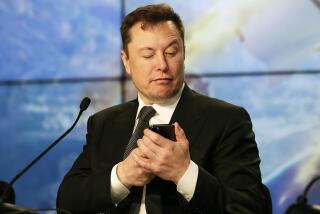Google surprise shake-up: Android chief replaced by Sundar Pichai
- Share via
SAN FRANCISCO -- In a surprise shake-up, Google has put Sundar Pichai in charge of its Android division, replacing Andy Rubin, who guided the mobile software to become the world’s most popular over Apple.
“Going forward, Sundar Pichai will lead Android, in addition to his existing work with Chrome and Apps. Sundar has a talent for creating products that are technically excellent yet easy to use -- and he loves a big bet,” Chief Executive Officer Larry Page wrote in a blog post Wednesday.
Pichai, who nearly defected to lead product at Twitter in 2011, works on the Chrome Web browser and operating system. His ascension suggests Google may be preparing to unify the Android and Chrome software.
Page said Pichai, a nine-year Google veteran, would be “doubling down on Android.”
“It does make sense when you see where Chrome is heading and where Android is heading. Why would you want different operating systems?” said BGC Partners analyst Colin Gillis. “Android is for phones and tablets and Chrome is for something closer to PCs. It would be ideal for Google to standardize. Now you have both functionalities under the same guy. We’ll see what he does. He had better not screw it up. Android is a big success right now.”
Rubin, the creator of Android and one of Page’s top lieutenants, built Android into the top software used by handset manufacturers, most notably Samsung Electronics. Android has leaped ahead of Apple’s software to command about 70% of operating systems on smartphones.
Rubin will begin a “new chapter” at Google, Page said.
Rubin took Android from a tiny startup to the mobile world’s top operating system.
Said Page: “Andy, more moonshots please!”
A Google spokeswoman declined to comment further.
Rubin co-founded Android in 2003. Google bought it in 2005.
ALSO:
Google engineer reveals early draft of Android mascot
Google’s Android chief says company does not need retail stores
Apple, Android combine for almost 90% of U.S. smartphone market
More to Read
Inside the business of entertainment
The Wide Shot brings you news, analysis and insights on everything from streaming wars to production — and what it all means for the future.
You may occasionally receive promotional content from the Los Angeles Times.










